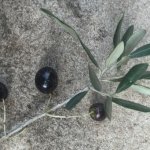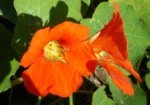In 1831, when Thomas Mitchell set off on his Journey into the Interior, he started the account metaphorically at Elizabeth Farm, in ‘A Garden’. The description of Macarthur’s estate served both as a symbolic starting point for his journey into the unknown, and also as a contrast to what he would describe as he journeyed into ‘the wilds’, leaving first the elegant houses, the gardens, the fields and, finally, even the scattered sheep-herds of the colony behind.
The house at Elizabeth Farm looked much to the visiting Mitchell as it does now, the major external difference being that the cast iron verandah posts you see today were then a row of turned wooden Greek Doric columns, giving the entry the appearance of a classical loggia.
It was 1831 when Mitchell visited, and Macarthur was not the man he once was. On the inevitable slide to the madness of his last days and suffering physically, he still took pride in his achievements as he walked Mitchell around the estate. I’ve included Mitchell’s full account here, as it portrays the once 800-acre estate in its prime:
A GARDEN: My first day’s journey, terminated near Paramatta, at the residence of Mr. John Macarthur. I was received by that gentleman with his usual hospitality, and although not in the enjoyment of the best health, he insisted on accompanying me over his extensive and beautiful garden, where he pointed out to my attention, the first olive-tree ever planted in Australia. Here I also saw the cork-tree in full 0f luxuriance—the caper plant growing amidst rocks—the English oak—the horse-chesnut—broom—magnificent mulberry trees of thirty-five years’ growth, umbrageous and green. Beds of roses, in great variety, were spread around, and filled the air with fragrance, while the climbing species of that beautiful flower was equally pleasing to the eye. I observed convict Greek pirates—‘acti fatis’—at work in that garden of the antipodes, training the vines to trellices, made after the fashion of those in the Peloponnesus.
The state of the orange-trees, flourishing in the form of cones sixteen feet high, and loaded with fruit, was very remarkable, but they had risen from the roots of former trees, which, having been reduced to bare poles by a drought of three years’ duration, had been cut off, and were now succeeded by these vigorous products of more genial seasons. Mr. Macarthur assured me, that by adopting this plan, many fruit-trees, after suffering from the effects of long-continued drought, might be renovated successfully. The want of moisture in the climate of Australia, may occasionally compel the gardener to resort to such extreme measures for the preservation of his trees: but the orange has hitherto yielded a very profitable and constant return to those, who have attended to its cultivation in this colony. The luxuriant growth of the apple and pear, in a climate so dry and warm, is a remarkable fact; and when we consider the exuberance of the vine in the few spots, where it has as yet been planted; we are justified in anticipating from the variety of aspect and unbroken soil in these southern regions, that many a curious or luxurious wine, still unknown, may in time be produced there.
But the garden, to him who seeks a home in distant colonies, must ever be an object of peculiar interest; for there, while cultivating the trees, fruits and flowers of his native land, the recollection of early days, and of the country of his birth is awakened by the vivid colours of the simple flower which his industry has reared, and which he knows to be a native of the soil to which he himself owes his existence.
Mitchell portrays Macarthur’s garden as both symbol of ‘improvement’ and as touchstone, both of personal recollections and of Western – and here we read ‘British’ – civilization. Grape vines and olive trees are loaded with neo-classical symbolism; these are after all the plants of Greece and Rome. Coupled with the English oak tree and the rose and you have the symbols of a transplanted society.
The Great Seal of NSW even portrayed the classical personification of ‘Industry’ surrounded by bees and tools, while beyond the city rose. The motto – Sic Fortis Etruria Crevit, or ‘Thus Etruria grew strong’ – is a line from the classical epic The Aeneid, by the Roman poet Virgil, and evokes the creation of a new society by the exiled Trojans in their new home in Italy. The message is that by sheer effort New South Wales would rise like Etruria. To educated men of the late 18th and early 19th century, like Macarthur and Mitchell, couched in the classics and speaking fluent Latin, this imagery was instantly recognisable.
Imagery aside, the olives are particularly significant for another reason. While much of the garden is a recreation, evoking the original plantings, many trees survive from the 19th century. The olives that stand to the west of the carriage loop may well have been planted as early as 1805. They are rare survivors indeed. Gary Crockett, my colleague and predecessor as curator at Elizabeth Farm, has researched the Macarthur olives, and the introduction of the tree to Australia. You can read his article here.
“But what about the ‘Greek pirates’?” I hear you cry. They’ll be making an appearance later in the year.
Sources:
Mjr. Thomas Livingstone Mitchell, Three expeditions into the interior of eastern Australia, Vol. 1: Journey in search of the Kindur in 1831-32. London, T W Boone. 2nd Edn., 1837.
You can read more of Mjr. Thomas Mitchell’s account here.





